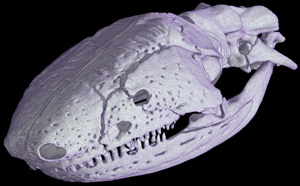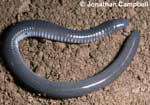The Mexican burrowing caecilian (Dermophis mexicanus) is a fossorial species that ranges from southern Mexico to northwest Colombia (Duellman and Trueb, 1986). Adults range from 300mm to 500mm in length (Grzimek, 2003) and their diet consists of termites, crickets, snails, slugs, and earthworms (Jared et al., 1999). |
|
Caecilians are a group of limbless amphibians. Limbs and limb girdles are absent in all extant caecilians and the majority of species also lack a tail. Extant caecilians comprise 33 genera and 170 species that may be aquatic, terrestrial, or fossorial. They are distributed throughout the tropics, although they are not found in Madagascar, central Africa, or the Oceanic region. Caecilians are the least studied group of amphibians because most species spend the majority of their lives underground or underwater (Pough et al., 2004).
Caecilians differ from other amphibians in having a compact skull, a trait known as stegokrotaphy. The skull is completely roofed except for openings for the eyes, nares, and tentacle. However, some species have an open temporal region to facilitate kinetic movement of the skull, a trait known as zygokrotaphy. All caecilians have a fused maxilla and palatine, known as the maxillopalatine. Additionally, all the occipital elements and the paraspheniod are fused into a single element called the Os basale. In derived species of caecilians such as Dermophis mexicanus and Typhlonectes natans, the nasals and premaxillae also fuse to form the nasopremaxilla (Duellman and Trueb, 1986; Pough et al., 2004). All caecilians have a unique chemosensory organ located on the head called the tentacle. The tentacle exits the skull through the tentacular foramen or groove located between the nares and orbit (Pough et al., 2004).
Reproduction in caecilians is oviparous or viviparous and fertilization is internal. Although some oviparous species lay eggs in water, other species deposit eggs terrestrially and maternal care for the eggs is common. Most oviparous species have aquatic larvae but direct development occurs in some terrestrial species. In viviparous species, embryos are nourished by secretions from oviduct walls of the female. Specialized fetal teeth in the young are used to stimulate cells in the oviduct walls to produce secretions (Pough et al., 2004). Dermophis mexicanus is a viviparous species with an 11 month gestation period. Litters average between four and eleven young. The reproductive season is in the early rainy season in May and June. Females reach sexually maturity at two years of age and males at three years.
Additional Information on the Skull
Click on the thumbnails below for labeled images of the skull in standard anatomical views.

About the Species
This specimen was collected from Depto. San Marcos, Guatemala. It was made available to The University of Texas High-Resolution X-ray CT Facility for scanning by Dr. David Cannatella of The University of Texas and the Amphibian Tree of Life project (EF-0334952). Funding for scanning and image processing was provided by Dr. Cannatella's grant, and funding for additional image processing was provided by a National Science Foundation Digital Libraries Initiative grant to Dr. Timothy Rowe of The University of Texas at Austin..

About this Specimen
This specimen was scanned by Philip Watson on 24 September 2004 along the coronal axis for a total of 585 1024x1024 pixel slices. Each slice is 0.0376 mm thick, with an interslice spacing of 0.0376 mm and a field of reconstruction of 17 mm.

About the
Scan
Literature
Duellman, W. E. and L. Trueb. 1986. Biology of Amphibians. Johns Hopkins, Baltimore, 670 pp.
Jared, C., C. A. Navas, and R. C. Toledo. 1999. An appreciation of the physiology and morphology of the caecilians (Amphibia: Gymnophiona). Comparative Biochemistry and Physiology Part A 123:313-328.
Hutchins, B., W. E. Duellman, and N. Schlager (eds). 2003. Grzimek's Animal Life Encylopedia, Second edition, Volume 6, Amphibians. Gale Group, Farmington Hills, MI, 507pp.
Nussbaum, R. A., and M. Wilkinson. 1989. On the classification and phylogeny of caecilians (Amphibia: Gymnophiona), a critical review. Herpetological Monographs 3:1-42.
Pough, H. F., R. M. Andrews, J. E. Cadle, M. L. Crump, A. H. Savitzky, and K. D. Wells. 2004. Herpetology. Pearson Education, Inc., Upper Saddle River, NJ, 726 pp.
Wake, M. H., and J. Hanken. 1982. Development of the skull of Dermophis mexicanus (Amphibia: Gymnophiona) with comments on skull kinesis and amphibian relationships. Journal of Morphology 173:203-224.
Links
Information and images of Dermophis mexicanus on AmphibiaWeb (University of California, Berkeley).
D. mexicanus on the Amphibian Species of the World website (American Museum of Natural History).

Literature
& Links
Front page image.
|  |

Additional
Imagery
|















